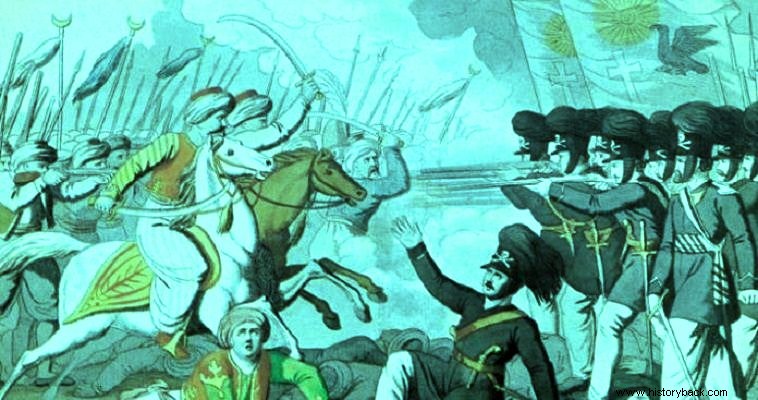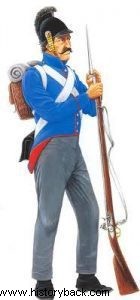
In 1826 the Greek Revolution faltered. In the Peloponnese, Ibrahim was literally threshing, with Kolokotronis desperately trying to stop him. In Roumeli the situation was also tragic. The heroic Messolonghi had fallen and Kioutachis was now also besieging Athens.
The campaign against Kioutachi was undertaken by Georgios Karaiskakis, but it was decided to assist the Tacticon, under the French colonel Charles Favier (Karolos Favieros). Faviero undertook the campaign with the A, B and C Battalions of Infantry, a company of horseless cavalry (Apostolic Company), an n company of Philhellenes of 70 men and a company of "Artillerymen" with four light guns.
The first two battalions were complete and each had six companies with a total of 720 men. C Battalion had only two companies with a total of about 200 men. The regular units joined the disorderly warriors of Karaiskakis at Eleusis where, in vain, they waited for the arrival of the regular cavalry under the Portuguese Almeida, who did not come due to his involvement in Moria.
According to Captain Christos Byzantios, the Tactical continued with about 1,850 men (1,600 line infantry, 80 gunners, about 150 men in the two independent companies and military music). The miscreants, according to Byzantium, numbered 2,500 warriors. However, Perraivos reports that the miscreants numbered around 4,000.
These forces, after crossing Mount Aegaleo, camped where Palataki is today in Haidari. Karaiskakis developed disorderly sections on the wall of the garden there. The forces of the generals Heliotis and Notaras were deployed on a nearby hill, covering the right flank of the fortified ones in the garden. The other disorderly divisions (of Kriezotis, Serbus and the body of the Eptanesians), covered the left side of the garden. The Tactic was deployed between the garden and the Greek right, supporting its left flank on the garden and its right flank on the drums of the commander-in-chief Heliotis.
At first light the following day (August 6, 1826) Turkish horsemen approached the Greek positions to be spotted, but received fire and withdrew. Soon, however, strong Turkish cavalry forces attacked the Greek right and especially the left flank. Immediately Karaiskakis and Favieros decided to reinforce the Greek wings. So the Philhellenic Company was sent to the right and to the left, where the danger was greatest, the First Infantry Battalion (A TP).
The commander, the Frenchman Robert, of the A TP formed his men into a phalanx of attack ("phalangan piknin", says Byzantius, probably meaning a phalanx per company, i.e. a formation with a front of 40 men and a depth of 18 men) and instead of limiting himself to passive defense ordered a spear attack!
The A TP did attack with its flag unfurled and drums beating against the Turkish cavalry and put it to shameful flight... It was a rare occasion that infantry of the period attacked and defeated cavalry in the open field. Until then similar attacks, not always successful, had been tried mainly by the Austrians.
At the same time on the Greek right the Philhellenes fought fiercely with the Turkish cavalry and when pressed they formed a sort of square, repelling the numerous enemies with bayonets and fire. But because they were in danger, as they were few, of annihilation, Faviero sent a detachment of the B TP to reinforce them. The skirmish ensued with the spears against the Turks, after first hitting them with fire and driving them to flight.
In this way, the first conflict of Chaidarios ended, with Tactiko taking the lead and winning the admiration of Karaiskakis as well. But the Turks came back again this time with infantry and cavalry and artillery. Again the Turks threw their weight on the Greek left flank.
The Turks, who outnumbered the Greeks by at least 2:1, put a lot of pressure on the Greek positions. Then Faviero unleashed the Tactic again. With the A and B TP in a dense attack phalanx formation, covered on the flanks by the Apostolic Company and the Philhellenic Company, he attacked with momentum against the Turks at marching pace (120 steps per minute), supported by all four of his light guns.
The appearance of the Regular marching undisturbed against the Turks also enlivened the disorderly sections that were suffering from the Turkish artillery and had reached the limit. The A TP continued the attack against the Turkish artillery which was also supported by cavalry. Nevertheless, although he was under heavy fire with cannonballs, he attacked with a step of offense, momentarily losing his coherence.
Nevertheless, the battalion swept the Turks and repelled an aggressive return of the enemy cavalry. The Tactic pursued the Turks and forced them to retreat as far as Athens. Favieros then insisted that the pursuit of the Turks by the whole of the Greek forces should continue. However, Karaiskakis, knowing the weakness of his unruly soldiers against the Turkish cavalry, had the opposite opinion and thus the battle ceased.
It was a great victory for the Greeks in which Tacticus was particularly distinguished, whose men managed to defeat even the Turkish horsemen...

Regular soldier in the uniform of 1825. He wears a distinctive helmet made of hardened leather, a musket and a bayonet. Design by Stelios Nigdiopoulos.
